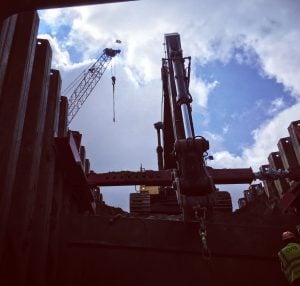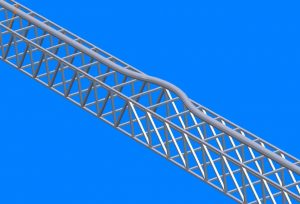Properly Identifying Scaffold Types and Foundations
Is your scaffold supported? I sure hope so since an unsupported scaffold isn’t much of a scaffold. Can a scaffold be supported but yet not supported? Yes it can but that’s a dumb question. Obviously all scaffolds require support, some from the ground and some from above, such as the roof of a building. Do we care if a scaffold is supported but yet not supported? Well, you should since you need to know the type of scaffold you have if you expect to have a safe scaffold and one that is in compliance with recognized standards. The big question is: how are scaffolds classified?
There are three types of scaffolds: Supported Scaffolds, Suspended Scaffolds and Aerial Platforms. Supported Scaffolds are temporary elevated platforms that are supported by rigid means such as legs, pole or uprights. Suspended scaffolds are temporary elevated platforms that are supported by non-rigid means such as chains or ropes. Aerial platforms, or at least aerial devices are described by the American National Standards Institute, ANSI, as “Any device, extensible, articulating, or both, which is primarily designed and used to position personnel. The device may also be used to handle material, if designed and equipped for that purpose.”
When determining what type of scaffold you may have, and of course you want to do this so you know which OSHA standards apply, you need to ask yourself a few questions. The first question to ask is probably the most important: Is the elevated platform actually a scaffold? This is important since the answer determines which regulations and standards apply. If your platform isn’t elevated, it’s not temporary, and it isn’t supporting employees or materials or both, it isn’t a scaffold. On the other hand, if you’re standing on a table attempting to change a light bulb, and your boss told you to do it, then you have a scaffold. In fact, you have a Supported Scaffold since the platform (the tabletop) is being supported by rigid legs. Of course, I’m sure you used a ladder to get to the table top since you certainly don’t want to violate any safety standards.
Once you have determined that your platform is a scaffold, then you need to determine if it is a Supported Scaffold, a Suspended Scaffold of an Aerial Platform. As stated earlier, if the platform has a rigid support, it is a Supported Scaffold. Besides tables, other examples of Supported Scaffolds include Tubular Welded Frame Scaffolds, Systems Scaffolds, Tube & Coupler Scaffolds, Pump Jack Scaffolds, Horse Scaffolds and Tank Scaffolds.
If your platform is elevated and supported by a rope or two, then you have a Suspended Scaffold. Examples include the porch swing your neighbor stood on to knock down the wasp nest, Single and Two Point Suspended Scaffolds such as a window washer’s scaffold, Catenary Scaffolds and a Multi-point Suspended Scaffolds. Remember that a Suspended Scaffold is a temporary elevated platform supported by non-rigid means. Besides wire rope this can also include chains, hemp rope, clothes line (if it’s strong enough), and slings.
As with any categorization, there has to be an exception or two, something to get everyone confused. And since I don’t want to disappoint you, scaffolds have their exceptions. The first, which isn’t really an exception but more of a clarification, is the hanging scaffold. A hanging scaffold is a scaffold normally constructed of rigid metal tubes and is hanging down from a structure above. While the usual assumption is that this type of scaffold is a Suspended Scaffold such is not the case! Since it is constructed of rigid tubes, it is a Supported Scaffold even if it is “suspended” from above. These scaffolds are referred to as Hanging Scaffolds or Hung Scaffolds.
Masons’ Adjustable Supported Scaffolds are the common exception to the supported/suspended classification. A Masons’ Adjustable Supported Scaffold has a platform that is supported by suspension ropes and a redundant (back-up) tower support. The suspension ropes are supported by rigid towers constructed of metal tubes. This results in a tower that is both a Suspended Scaffold and a Supported Scaffold. Consequently both the OSHA Construction Supported Scaffold Regulations [29 CFR 1926.451(c)] and the OSHA Construction Suspended Scaffold Regulations [29 CFR 1926.451(d)] may apply, depending if the platform is supported by ropes only or also by the tower itself.
You are in luck if the temporary elevated platform and its supporting structure is a Boom Supported Elevating Work Platform (boom-lift), Self-propelled Elevating Work Platform (scissors lift), a Vehicle-Mounted Elevating and Rotating Aerial Device (truck mounted boom lift), or a Mast-Climbing Work Platform (mast climber), because neither the Supported Scaffold nor the Suspended Scaffold regulations apply. In fact, you need to use the specific American National Standards institute (ANSI) standards for these devices.
Supported Scaffold or Suspended Scaffold or Aerial Platform, you get to decide which one it is by what is holding up the platform—it’s that easy. However, if you are using a table as a scaffold, you may want to rethink that idea. If your platform is suspended from your mother’s clothesline you really want to rethink that one. Want help in identifying the type of scaffold you’re dealing with? The best way is to get proper scaffold training from a qualified trainer.













